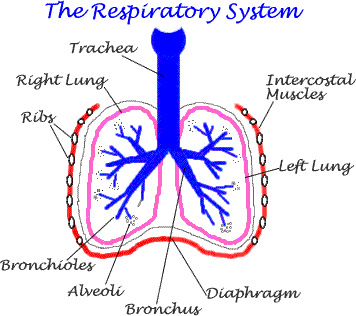Ventilation: The process of bringing fresh, oxygenated air into the alveoli and removing air containing carbon dioxide from the alveoli.
Air is inhaled into and exhaled from the lung via the mouth or nose, trachea, bronchi, bronchioles and alveoli. Muscles within the rib cage as well as the muscular diaphragm are used change the air pressure within the lungs, causing the movement of air.
 Inhalation:
Inhalation:
1. The external intercostal muscles contract, moving the ribcage upwards and outwards.
2. At the same time, the diaphragm also contracts, moving downward as it becomes flatter.
3. Both the previous 2 steps increase the volume of the thorax or chest, causing the pressure within the thorax to decrease.
4. When the pressure in the thorax decreases below that of the surrounding air, air flows into the lungs from outside the body (This would be like diffusion, from high concentration to low concentration.). Air continues to enter the lungs until an equilibrium (equal pressures) between the internal and external environments is reached.
5. Since there is a high concentration of oxygen in the alveoli and less in the blood, oxygen diffuses into the blood.
1. Since there is a higher concentration of carbon dioxide in the blood than in the alveoli, carbon dioxide diffuses into the alveoli.
2. The internal intercostal muscles contract, moving the ribcage downwards and inwards.
3. At the same time, the abdominal muscles contract, pushing the diaphragm upwards towards the lungs.
4. The combination of the latter 2 muscle contractions decrease the volume of the thorax. This increases the pressure of the gases within the lungs.
5. When this pressure is higher inside the lungs than outside the body, air is forced from the lungs to the external air. This outward movement continues until an equilibrium (equal air pressures) is reached between the concentrations of air in the lungs and external air.